July 02, 2009
Guitar-Making Details: Stacked Cellulose Binding and Purfling |
|
Here's a fun little project that's unfolding in The Workshop right now. A very good customer of ours has commissioned an Artist Korina with some stacked tortoise shell binding. The twist is that he wants a natural ivoroid stripe on both the top and the side. Because there aren't any pre-laminated strips available, we have to lay them up by hand right on the guitar.
This is the first two layers being laid into the binding rout. The tort goes down first, then the natural on top. Just for fun, we decided to cut the whole outline out of a flat sheet, so that the end grain of the ivoroid will show on the edge of the guitar when we're done.
| 
|
The next step is to glue the pieces of the inside upper binding on. You can see how the identical stripes for top and side have been done. The next step is to lay up the thicker tortoise strip into this.
| 
|
Next, we do the same thing on the neck and headstock. Here you can see Tom making the miter joint on the lower strip at the fingerboard end.
We'll pick up the story a little later next time so you can see what it looks like.
| 
|
|
July 02, 2009
Monaco III Guitar With 3 Lollar P90s
Just because we love this guitar, and it looks fantastic in Red Transparent lacquer. This little devil will surprise you with jangly and shimmering tones that are usually associated with a certain type of bolt-on neck guitar. Then, with a quick twist of the chicken-head knob, you're rockin' with Leslie West style fatness. The neck pickup will do amazing SRV duties—what a versatile axe. One of my personal faves.
| 
|
|
July 06, 2009
Custom Guitar Headstock Binding Update |
|
Tom is moving ahead with our multi-ply tortoise shell binding/purfling project. here's a closeup of the pre-fabbed side pice on the headstock.
The side is the only place where he can make an assembly because everywhere else the binding will be curved. It's a good shot because it tells the story of how the entire job is constructed—sort of a cutaway view.
| 
|
This is what it looks like when finished. It's not practical to make strips of built up binding and then bend them because even with heat you'd get massive distortion. This way, although very time consuming, yields a much more tidy result.
| 
|
Meanwhile, Dave is sanding the f-hole binding flush with an orbital sander to check for uniformity before we go further with the body. We'll drop in again in a couple of days to see how things shape up with the neck.
| 
|
|
July 08, 2009
Jol Dantzig On Stage with Tom Dumont of No Doubt
Scott is working hard to edit the video so you all can get a look at Tom's gear and see him demo some guitars on stage with our own Guitar Guru Jol Dantzig. In the meantime...
| 
|
|
July 20, 2009
If you beat on it... is it a drum?
Guitars are percussion instruments right? Just ask Pete Townshend. Kurt Cobain knew how to pound on an axe too. I swear that half of the current crop of rockers are generating more rhythmic sound than any discernible pitch anyway.
Here's what happens when you connect the dots between drums and guitar in another way...
| 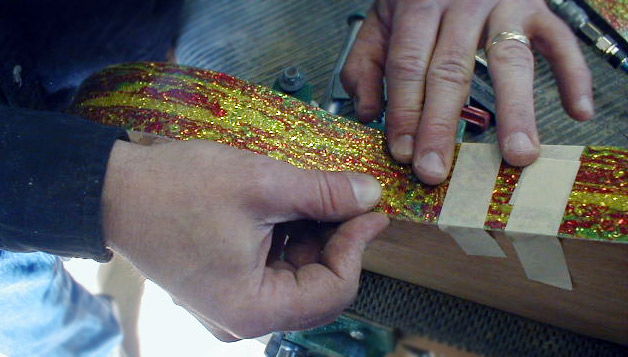
|
|
July 29, 2009
From Concept to Stage in Eight Days |
|
Generally speaking, we don't like to rush things—haste makes waste you know. I can't even count the times I've watched otherwise intelligent people throw away money in the long run due to impatience trying to get results quickly. However, sometimes a deadline is real, and the benefit of speed outweighs the potential for sloppiness.
Our "mystery package" component guitar for Rick Nielsen presented just such a challenge. We needed to build a guitar in an incredibly short time frame in order to be photographed with a matching drum kit. The material, called citrus mod glass, was on its way from Bun E. Carlos even though we'd never laminated drum covering on a guitar, I knew we could do it.
Dave and I had sourced some existing components that would work already, so It was just a matter of getting everyone on board with the idea of dropping everything when the stuff arrived.
| 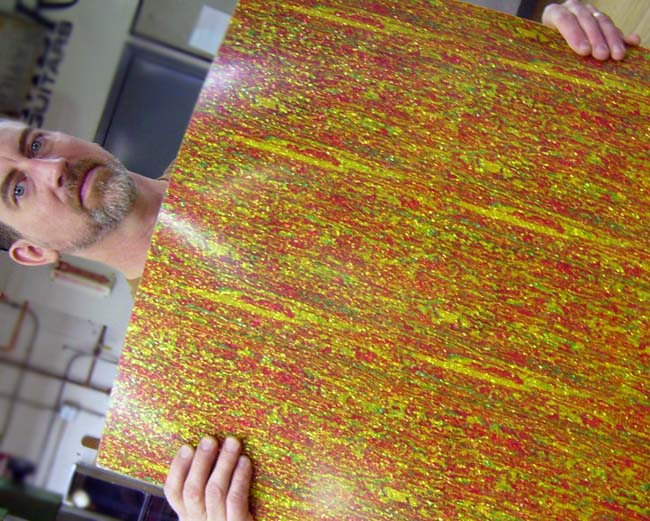
|
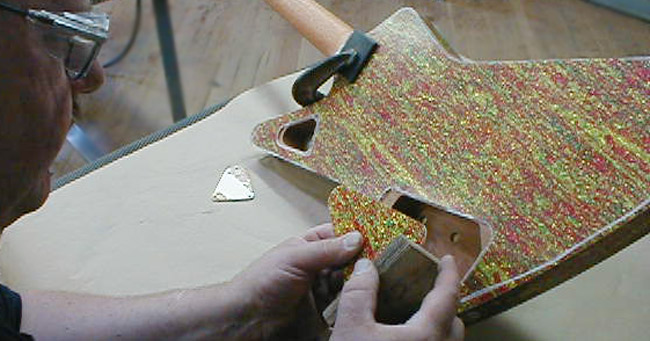
| 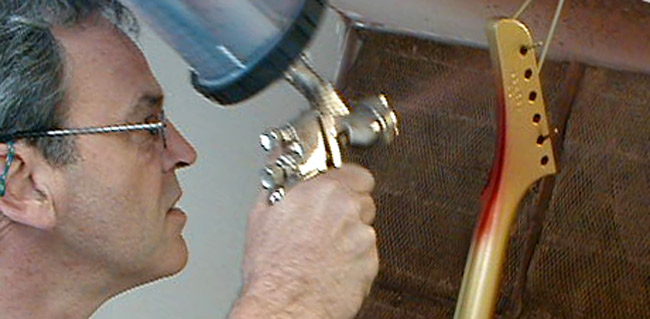
|
Because we allow our necks to "normalize" over a period of weeks before machining the radius on the fingerboard we needed to find a neck already in progress. Luckily there was something on the shelf that had been rejected for a blemish. No problem, this guitar was going to be sprayed in opaque color and covered with drum nitron!
It was then just a matter of cutting and gluing, with a little experimentation with the heat gun first. Gary shot the guitar with a PPG material that locks up in a few hours, and that allowed us to move the process along big time.
The guitar got boxed up on Thursday—six days after the laminate arrived, and by Saturday Rick had it on stage. That's teamwork and strategy. Nice work guys!
| 
|
|
August 18, 2009
Limba Double-Stacked Guitar Coming along |
|
As the August temperatures rise outside, it's cool and dry inside the shop—perfect for making guitars. Checking in on the double-stacked binding project finds good progress being made. Tom has finished the neck and the transitions are really beautiful.
There are a lot of ways to do this, and no single technique is necessarily the "best". We've always perched the nut on top of the headstock binding, so that's the traditional Hamer look we're sticking to on this build. It gets a little complicated to stack everything up, but we've never shied away from doing things the hard way.
| 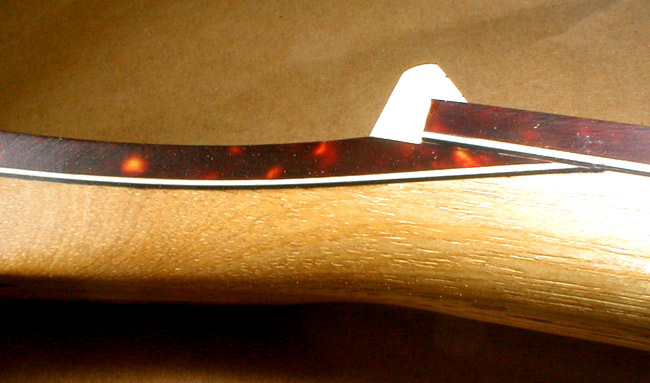
|
Speaking of the hard way, a lot of you have written in to ask how we managed to lay the under-purfling flat around the body, so here's the answer. Here's Dave using the spindle sander to shape the inside outline (does that make sense?) of the piece that gets glued to the body first. He makes a tracing on a sheet of the cellulose material, then rough cuts it on the bandsaw (note the entry cut at the neck joint area). Then using the sander, he brings it to a very close fit.
| 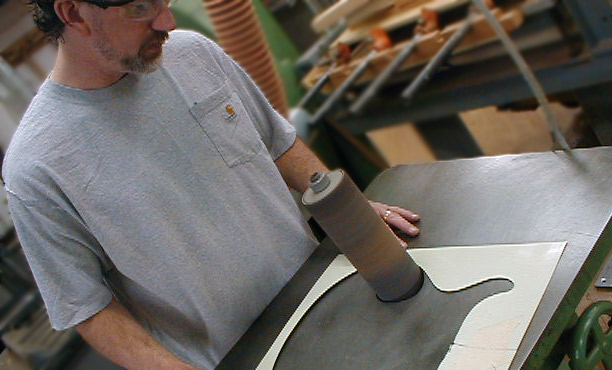
|
In this shot, I'm checking the fit and marking where more needs to be removed. It's a matter of going back and forth until the sheet slips right down into the bottom of the binding channel. I like the way this looks when we're done, as the grain of the material reveals itself differently all around the body. It's a nice contrast to the top layer which follows the curve of the body as usual.
Bill Collings does a similar sort of thing on his headstock bindings, but I believe they cut the shape out on a laser. Sanding it by hand takes a lot longer, but that's OK as ours is only a single guitar. There's a lot of work in a one-off, but the results are going to be great.
| 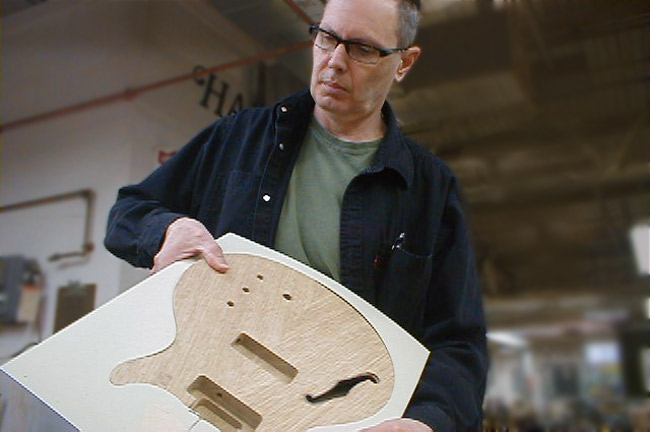
|
|
August 25, 2009
Beach Boys Promo Photo features Hamer Monaco
Readers of this page will be familiar with Scott Totten who is the Musical Director (MD) for The Beach Boys. Scott has been featured here before, and has been a tireless supporter of our work over the years.
Apparently, the band has just produced a new promotional slick, and Scott has managed to get his little darlin' Monaco III into the shot. Way to go Scott!
If you get a chance to see the band, don't pass up the opportunity because the musicianship is first rate. Thanks again to one of our friends in the trenches.
| 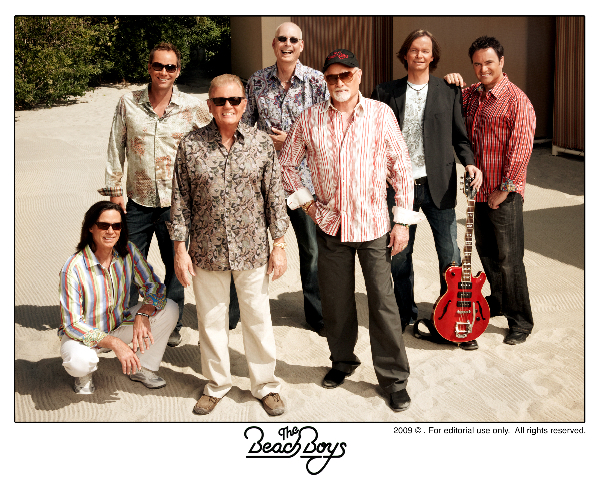
|
|
September 15, 2009
Tuesday in the Workshop |
|
Tuesday dawns cool, crisp and full of promise as we head into the tasks of the day. This is the time of year that many of us enjoy the most in New England, and the fall light streams into the shop with its flattering glow.
In the whitewood area of the shop, Tom is putting the final prep touches on a lovely quilt-topped Studio model. He's applied a light coat of Danish oil to help the adhesion of the first coats of nitro lacquer. This particular guitar has an ultimate-grade top and it's a sight to behold even before we get the clear coats on it. Somebody is going to be very happy with their purchase.
| 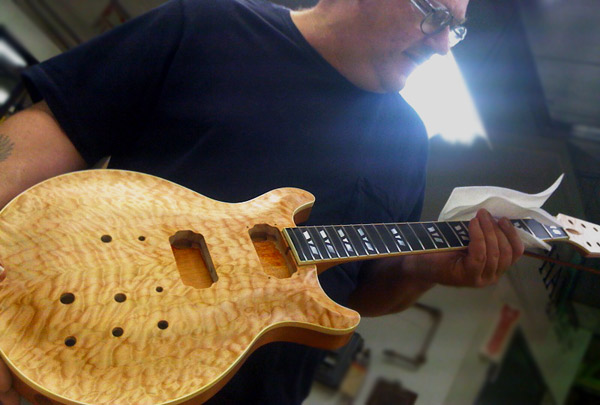
|
Over in the other corner, Todd is toiling away on the third round of sanding on the stacked purfling guitar. Each leveling takes about an hour, and it's one of the reasons our finishes look the way they do. Todd is using a hand block and a 2000 grit wet-or-dry paper to get the finish totally flat. Then he'll move over to the buffing wheel for another hour of polishing.
The thing I like about this guitar is that its simple appearance belies the huge amount of planning and handwork that goes into it. The details will reveal themselves slowly to the owner over time, which makes it a gift that keeps on giving. Substance over flash wins every time.
| 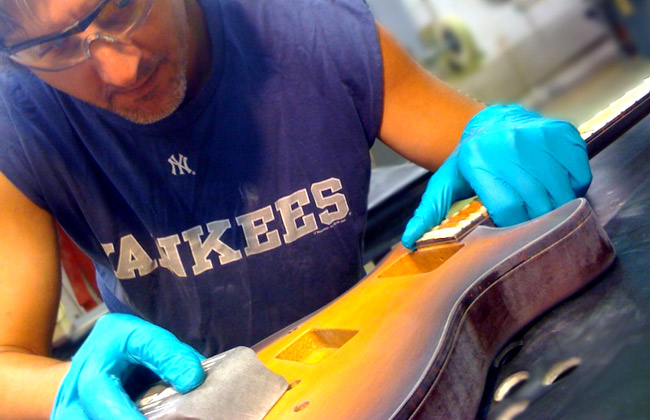
|
|
September 24, 2009
Stacked Purfling Guitar Ready
We've been documenting the progress of the Korina Artist guitar with stacked purfling for a while now; and at last it's ready. Todd did a wonderful job on the leveling and buffing—the guitar is as flat as a sheet of glass. I love the way the hardware is reflected in the lacquer. The changing grain of the ivoroid is apparent in this shot.
| 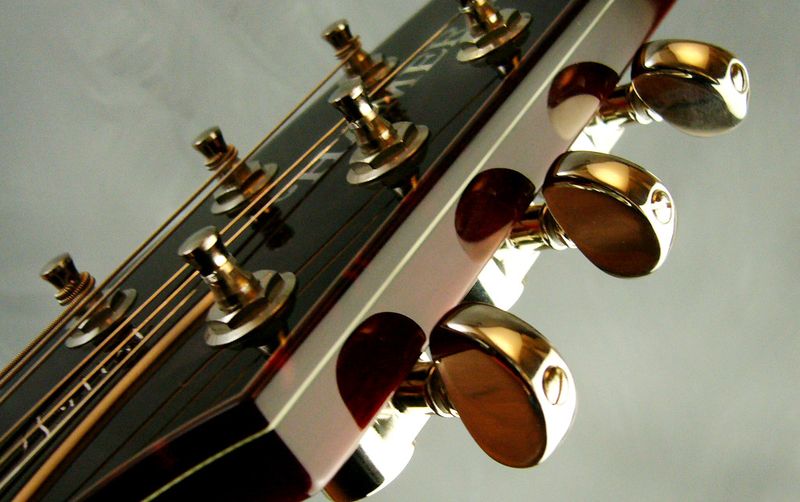
|
The bookmatched limba top is joined in a tasteful chevron pattern and subtly carved into an arch. You can see the little details like the inset strap button. There's a rubber shock washer under the button to prevent the finish from being damaged by pull from the strap. From this angle you can also see the interior ivoroid purfling stripe inside the F-hole.
| 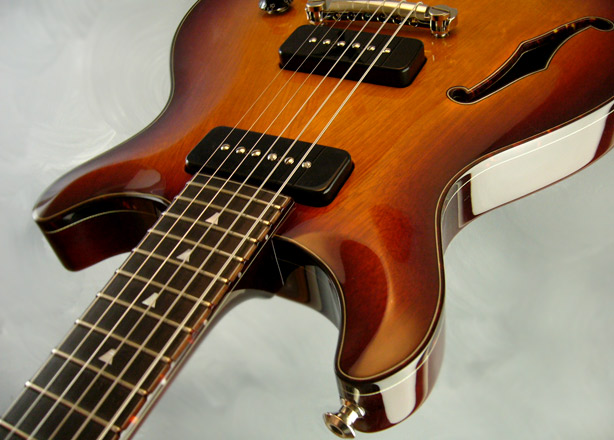
|
One place where we don't skimp on the effort is the tip of the headstock, or "scroll" as we call it. With the grained ivoroid showing here it's doubly important to level and buff the finish properly too. This is one of the things that separates our workshop from production shops and factories. Next time you're in a guitar store, take a look at this area to see how much care the builder puts into the places people don't usually look.
Schaller tuners mix fine German engineering with vintage style. With most of the other "famous" brands being built in China now, these are some of the last tuners being made to a high standard. They're extremely consistent and we rarely see one fail.
| 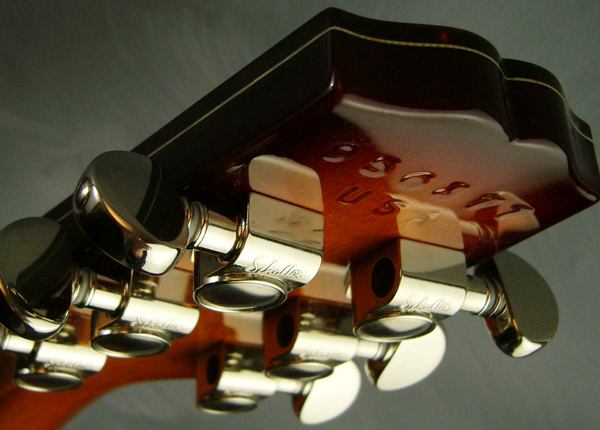
|
In this shot you can see the way the jazzburst color goes perfectly with the tortoise shell binding. Below you can clearly see the side purfling grain as well as the F-hole detail. The guys in the shop have taken the concept and added their own twist to go beyond what was asked of them—again.
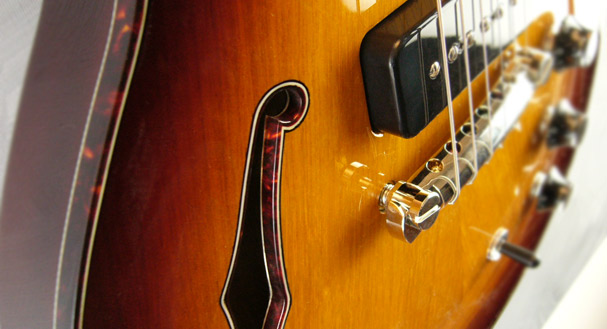
| 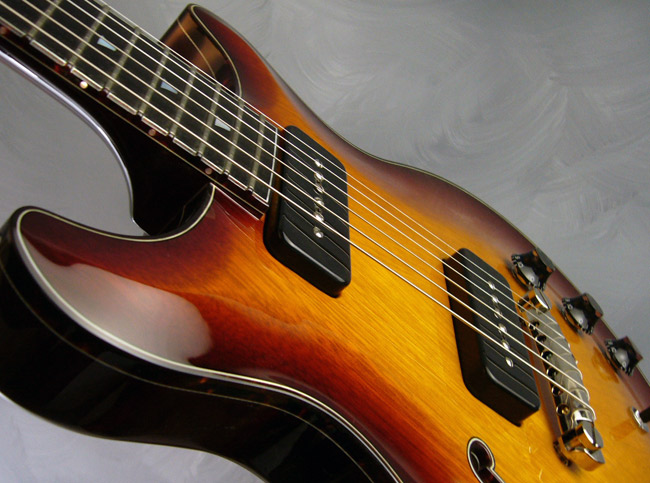
|
|
Previous Month
| Next Months
|
